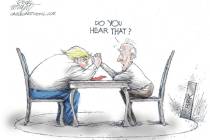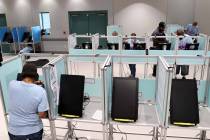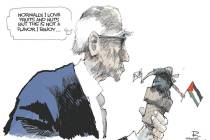LETTERS: History may help in ambulance feud
To the editor:
Regarding the current feud on ambulance transport between the Las Vegas Fire Department and American Medical Response, it’s kind of a sad fact when you realize that the city you have lived in most of your life has lost its institutional memory. Flash back to the late 1960s and early 1970s, and read the Review-Journal and Las Vegas Sun coverage about the ambulance wars of the time. Ambulance rates were skyrocketing, and the care of accident victims was sacrificed to the competitive need for revenues by the various ambulance companies.
Areas of the city historically associated with low pay or no pay went without efficient ambulance service. The triage system for accident victims was based on the quality of the car they drove instead of the seriousness of their injuries. Then a new marshal came to town in the form of Dr. Otto Ravenholt, the head of the Clark County Health District, and with the support of city commissioner and later Mayor Ron Lurie, he brought peace to the streets.
Instead of building a system based on the political whims of the community, officials looked at the then-developing emergency medical services systems nationwide and adopted a public-private utility model that was successful in providing quality victim care, within an optimum time frame and at an affordable and manageable cost structure. The key to the system’s success was its focus on providing care and adequate coverage to both the actual victims of accidents or sudden illness and to the at-risk populace at large. Transportation decisions were based primarily on the medical needs of the victim and the availability of the proper level of treatment facility, secondly on the specific desires of the victim or patient.
Also considered was how long a transporting unit would be out of its primary response area, in order to maintain optimum coverage for the at-risk population. Minor adjustments were made as needed to manage rates, response times and quality of service.
Now, it appears city of Las Vegas leaders have opted to throw victims of accidents and sudden illnesses back under the bus. Regardless of the effect on ambulance rates or coverage for at-risk populations, officials have decided to enhance city revenues, just like the ambulance company owners did in the old days. My questions: Who makes the decision to transport? Are there any financial incentives given to the treating medical personnel, such as extra pay for invoicing or collecting bills for treatment, that could influence transporting decisions? Are the system’s results, in terms of patient care, delays, lack of coverage and cost impact on ambulance rates, being reviewed by an outside or independent authority, such as the health district or another competent body? Is there a coherent business plan for the operation of the system, now and in the future?
My plea to all those involved is to please learn from history. The system was designed with a purpose. Don’t destroy it with short-term greed.
REX SHELBURNE
LAS VEGAS
Energy hike hits poor
To the editor:
Since the proposed rate increase from NV Energy, including a 50 percent increase in the fixed charge, is admitted to be subjective, the Nevada Public Utilities Commission should reject it because it hits the poorest the hardest (“NV Energy seeks to raise customer rates,” May 3 Review-Journal).
The goal of the rate structure should be to encourage less use of energy, which is best done by raising rates.
Thus, we should all urge the commission to have NV Energy come back with a revision that keeps fixed charges fixed at $10 a month.
GARY MUSSER
LAS VEGAS























